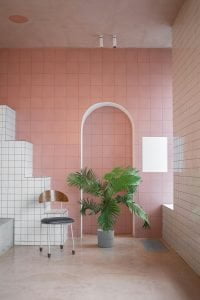How the Color of Paint Can Affect the Whole Room – Colour Psychology
Introduction
Colour is one of the most powerful tools in interior design. It can transform a space, set the mood, and even influence how we feel in a room. Whether you’re painting a bedroom, living room, or kitchen, the colour you choose can have a profound effect on the overall atmosphere. But how exactly does the colour of paint impact a room? Let’s dive into the details.
The Psychology of Color
Understanding colour psychology is essential for making the right choices in your home. Different colours evoke different emotions and can influence our mental state. For instance:
-
Red is a powerful colour that can evoke excitement and energy but can also be
overwhelming in large doses. -
Blue is known for its calming properties, making it ideal for bedrooms and
bathrooms. -
Yellow is associated with happiness and warmth but can be jarring if used
excessively.
By understanding these associations, you can choose colours that align with the mood you want to create in your space.
Warm vs. Cool Colours
Colours are typically categorised into two broad groups: warm and cool.
Warm Colours
Warm colours include reds, oranges, and yellows. These hues can make a room feel cozy and inviting, but they can also make a space feel smaller and more enclosed. If you want to create an intimate, comfortable environment, warm colours are the way to go.
Cool Colours
On the other hand, cool colours such as blues, greens, and purples are calming and can make a room feel more spacious. They’re perfect for areas where relaxation is key, like bedrooms or study areas.
Neutral Colours
Neutral Colours: The Power of Subtlety
Neutral colours like beige, grey, and white are incredibly versatile. They act as a blank canvas, allowing you to play with accents and furniture without overwhelming the space.
Creating Balance with Neutrals
Neutrals are perfect for creating balance in a room. They can soften bold colours, add warmth to cool tones, and bring light into darker spaces. A room dominated by neutrals can be soothing, timeless, and easy to update with accessories. Neutral colour is also a popular choice when it comes to living room colour, where people often opt to make the space feel more inviting.
 Bold Colours
Bold Colours
Bold Colours: Making a Statement
While neutrals are safe, sometimes you want to make a bold statement. Bold colors like deep blue, rich green, or vibrant red can add personality and drama to a room.
Tips for Using Bold Colours
When using bold colours, balance is key. You don’t want the colour to overpower the room, so consider pairing it with neutral tones or using it as an accent colour. Bold colours work well on feature walls, in alcoves, or in spaces that need a focal point.
The Impact of Lighting on Colour Perception
Lighting plays a crucial role in how colour is perceived in a room. The same paint colour can look drastically different depending on the light source.
Natural vs. Artificial Lighting
Natural light tends to bring out the true colour of paint, while artificial light can alter its appearance. Warm artificial lighting can make colours appear more yellow or orange, while cool lighting can make them look bluer. It’s essential to test paint colours under different lighting conditions before committing.
Room Size and Color
If you are looking for some room colour ideas, keep in mind that colour can dramatically change the perception of a room’s size. Light colours can make a small room feel larger and more open, while dark colours can make a large room feel more intimate and cozy.
Best Colour Choices for Small vs. Large Rooms
- Small Rooms: Opt for light, airy colours like soft blues, pale greys, or off-whites to create the illusion of space.
- Large Rooms: Darker shades like navy, charcoal, or forest green can make a large room feel more inviting.
Accent Walls: Adding Dimension
An accent wall is an excellent way to add depth and interest to a room without overwhelming the space with color. Recently, there has been a significant rise in creative painting designs within the interior design industry. Having some painting design around the house is a budget friendly way to make the space interesting while also controlling the budget.
Choosing the Right Wall for Accenting
Pick a wall that naturally draws attention, such as the wall behind a bed or foyer. The colour should complement the rest of the room while standing out enough to create a visual impact. By carefully selecting a focal wall, you can enhance the room’s overall design without overpowering the space. Consider how the chosen color interacts with the room’s lighting and existing decor to ensure a cohesive yet eye-catching result.
Ceiling Colours: The Fifth Wall
Often overlooked, the ceiling colour can significantly influence the room’s overall look.
How Ceiling Color Affects Room Perception
A lighter ceiling colour can make the room feel taller and more spacious, while a darker ceiling can create a more intimate, cozy atmosphere. Don’t be afraid to experiment with ceiling colours, especially in rooms where you want to make a statement.
Colour Harmony: Creating a Cohesive Space
Colour harmony is all about creating a cohesive look in your room by choosing colors that work well together.
Techniques for Achieving Color Harmony
- Monochromatic schemes: Use different shades of the same colour for a unified, sophisticated look.
- Analogous schemes: Choose colours that are next to each other on the colour wheel for a harmonious, soothing effect.
- Complementary schemes: Use colours that are opposite each other on the colour wheel for a vibrant, dynamic contrast.
Choosing the Right Paint Finish
The paint finish you choose can affect the final look of your room just as much as the colour itself.
Different Types of Paint Finishes
- Matte/Flat: Offers a non-reflective finish, ideal for hiding imperfections.
- Eggshell/Satin: Provides a slight sheen, perfect for living rooms and bedrooms.
- Semi-Gloss/Gloss: Highly reflective, best suited for trim, doors, and kitchens where durability is key.
Colour Trends: Staying Current
While it’s important to choose colours that you love, staying current with trends can help keep your home looking modern.
Popular Color Trends in 2024
In 2024, we’re seeing a rise in earthy tones, muted greens, and soft pinks. These colours offer a fresh yet timeless appeal, perfect for updating your space without making it feel dated.
DIY Tips for Painting
If you’re planning to paint your room yourself, here are some essential tips to ensure a professional finish.
Preparing Your Space for Painting
Start by cleaning the walls, filling in any holes, and applying painter’s tape to edges. Don’t forget to lay down a drop cloth to protect your floors.
Common Mistakes to Avoid
Painting is an art, and like any art, it requires attention to detail. Here are some common mistakes to avoid when painting your room:
Overwhelming the Space with Too Much Colour
It’s easy to get carried away with colour, but too much of it can make a room feel chaotic. Stick to a balanced palette and use bold colours sparingly to create focal points rather than overwhelming the entire space.
Ignoring Lighting When Choosing Colours
As mentioned earlier, lighting can drastically affect how colours appear in a room. Always test your paint samples under different lighting conditions to see how they change throughout the day.
Failing to Test Colors Before Painting
Never skip the testing phase. Paint a small section of your wall with your chosen colour and observe it over a few days. This helps ensure that the colour looks exactly how you want it in different lights.
Choosing the Wrong Finish
The finish of your paint is just as important as the colour. A high-gloss finish might be too shiny for a bedroom, while a matte finish might not be durable enough for a kitchen. Consider the function of the room when selecting your paint finish.
Not Preparing the Surface Properly
A common mistake is to start painting without properly preparing the surface. Make sure to clean the walls, patch up any holes, and sand down rough spots before you begin painting. This ensures a smooth and even finish.
Conclusion
Colour is a powerful tool in interior design, capable of transforming the look and feel of any room. Whether you want to create a cozy, intimate space or a bright, airy one, the right paint colour can make all the difference. Remember to consider the psychology of colour, how lighting affects colour perception, and the role of colour in altering room size and atmosphere. By carefully choosing your colours and finishes, you can create a space that reflects your personality and meets your needs.
FAQs
1. How do I choose the right colour for a small room?
Opt for lighter colours like soft blues, pale greys, or off-whites to create the illusion of more space. These colours reflect light, making the room feel larger and more open. A light colour design small room often feels airy and inviting, helping to combat any feelings of confinement.
2. What’s the best way to test paint colours?
Paint a small section of your wall with your chosen colour and observe it over a few days in different lighting conditions. This helps you see how the colour looks at various times of the day.
3. Can I use dark colors in a small space?
Yes, but use them sparingly. Dark colours can add depth and drama but can also make a small room feel more enclosed. Consider using a dark color as an accent rather than painting an entire room.
4. How often should I repaint my walls?
It depends on the room and the wear and tear it experiences. High-traffic areas like hallways may need repainting every 3-4 years, while bedrooms might only need a refresh every 5-7 years.
5. What’s the best finish for high-traffic areas?
Semi-gloss or satin finishes are ideal for high-traffic areas. They are durable, easy to clean, and resistant to scuffs and marks.








